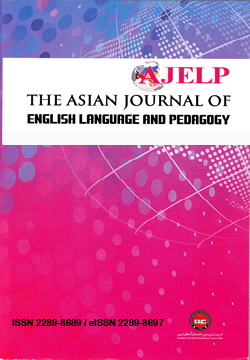Duplicity in political texts: Are lie-spotting strategies efficient in L2 contexts?
DOI:
https://doi.org/10.37134/ajelp.vol8.1.3.2020Keywords:
Lie-Spotting, Political, Semiotic, Strategy, VerbalAbstract
Deceitful behaviors are mostly verbal, largely culture-bound, and relatively political. Verbal deceitfulness gives us such a survival advantage that some evolutionary biologists believe that the capacity to speak and the ability to lie have been developed hand in hand. This study was an attempt to investigate the relative impacts of using verbal (VSL) and semiotic (SLS) lie-spotting strategies on Persian Speaking EFL learners’ interpretation of political discourse. A research sample of male and female EFL learners was selected and assigned into two groups (n1=30, n2=22). Participants were all recognized as intermediate EFL learners after running an English general proficiency test (PET). Later, in two parallel experiments, the participants were exposed to VLS and SLS in 16 classroom sessions before they performed on a post-intervention political discourse comprehension. Both experimental groups showed a lapse in their posttests. Descriptive and inferential statistics supported meaningful impacts of both verbal and semiotic modalities of lie-spotting strategies despite the participants’ regressive performance in both experiments on the post-intervention test. The researcher concluded that applying VLS and SLS was a novelty to the subjects in this study who were required to differentiate between their pure comprehension of the political texts and dubious interpretation of the intended message which in turn suggests incorporating more political and journalistic texts and employing lie-spotting strategies in L2 contexts.
Downloads
References
Bucciol, A. & Zarri, L. (2013). Lying in politics: Evidence from the US. Working Paper Series, Department of Economics University of Verona, (22). Retrieved from
http://dse.univr.it/home/workingpapers/wp2013n22.pdf
Cao, J., Crews, J., Lin, M., Burgoon, J., & Nunamaker, Jr. J. (2003). Can people be trained to better detect deception? Instructor-led vs. web-based training. AMCIS 2003 Proceedings, (76). Retrieved from https://pdfs.semanticscholar.org/10ea/00d56fd97d1308bd181a574d4afc3f0f1f22.pdf
Chilton, P. (2004). Analyzing political discourse: Theory and practice. New York: Routledge.
Ekman, P. (1992). Telling lies: Clues to deceit in the marketplace, politics, and marriage (2nd ed.). New York-London: W W - Norton & Company
Fairclough, N. (2012). Critical discourse analysis. In J.P. Gee & M. Handford (Eds.), The Routledge handbook of discourse analysis (pp. 9-20). New York: Routledge.
Fairclough, N. (2011). Semiotic aspects of social transformation and learning. In R. Rogers (Ed.), An introduction to critical discourse analysis in education (pp. 119-127). New York: Routledge.
Furnham, A. (2014). The Clues to deceit: The psychology of lie detection. Psychology Today. Retrieved from
https://www.psychologytoday.com/blog/sideways-view/201412/the-clues-deceit-the-psychology-lie-detection
Gee, J. P. (2011). Discourse analysis: What makes it critical? In R. Rogers (Ed.), An introduction to critical discourse analysis in education (pp. 23-45). New York: Routledge.
Gee, J. P. (1996). Social linguistics and literacies: Ideology in discourses (2nd Ed.). London: Taylor & Francis.
Kenzhekanova, K., Zhanabekova, M., & Konyrbekova, T. (2015). Manipulation in political discourse of mass media. Mediterranean Journal of Social Sciences, 6 (4), 325-332.
Kermond, J. (2013). Three ways to spot a liar. Advisor Perspectives. Retrieved from
http://www.advisorperspectives.com/subscribers/subscribe.php
Keyes, R. (2004). The post truth era. New York, NY: St. Martin’s Press.
Lasswell, H. D. & Leites, N. C. (1965). Language of Politics Studies in Quantitative Semantics. Massachusetts: MIT Press.
Levine, T.R., Feeley, T.H., McCornack, S.A., Hughes, M., & Harms, C. (2005). Testing the effects of nonverbal behavior training on accuracy in deception detection with the inclusion of a bogus training control group.
Western Journal of Communication. Retrieved from
https://pdfs.semanticscholar.org/7159/b1d1fc62eadfc4f1d71f53189267c35a3b81.pdf
Masip, J., Garrido, E., & Herrero, C. (2004). The nonverbal approach to the detection of deception: Judgmental accuracy. Psychology in Spain. Retrieved from
http://www.psychologyinspain.com/content/full/2004/8005.pdf
Meyer, P. (2010). Lie-spotting: Proven techniques to detect deception. New York: St. Martin’s Press.
Newman, M. L., Pennebaker, J. W., Berry, D. S., & Richards, J. M. (2003). Lying words: Predicting deception from linguistic styles. Personality and Social Psychology Bulletin. Retrieved from
https://www.albany.edu/~zg929648/PDFs/Newman.pdf
P´erez-Rosas, V., Abouelenien, M., Mihalcea, R., Xiao, Y., Linton, C., & Burzo, M. (2015). Verbal and nonverbal clues for real-life deception detection. Association for Computational Linguistics. Retrieved from
http://www.aclweb.org/anthology/D15-1281
Perloff, R. M. (2014). The dynamics of political communication: Media and politics in a digital age. New York: Routledge.
Rogers, R. (2011). Critical discourse analysis in education (2nd Ed.). New York and London: Routledge.
Sebeok, T. A. (2001). Signs: An introduction to semiotics (2nd Ed.). Toronto: University of Toronto Press.
Uso´-Juan, E., Martinez-Flor, A. (2006). Current trends in the development and teaching of the four language skills. New York, NY: Walter de Gruyter GmbH.
Van Dijk, T. A. (2006). Discourse and manipulation. Discourse & Society 17(2). Retrieved from
http://www.discourses.org/OldArticles/Discourse and manipulation.pdf
Van Dijk, T. A. (1986). Racism in the press. London: Arnold.
Vrij, A. (2001). Stereotypical verbal and nonverbal responses while deceiving others. Personality and Social Psychology Bulletin, 27 (7), 899-909.
White, A. (2017). Ethics in the news. Ethical Journalism Network. Retrieved from
http://ethicaljournalismnetwork.org/wp-content/uploads/2017/.../ejn-ethics-in-the-news.pdf
Wilson, J. (2007). Political discourse. Blackwell Reference Online. Retrieved from
http://www.blackwellreference.com/subscriber/tocnode?id=g9780631205968_chunk_g978063120596821.
Wodak, R. (2012) Politics as usual: Investigating political discourse in action. In J.P. Gee & M. Handford (Eds), The Routledge handbook of discourse analysis (pp. 525-540). London & New York, NY: Routledge.
Wodak, R., & Meyer, M. (2001). Methods of critical discourse analysis. London: SAGE Publications.
Woon, J. (2017). Political Lie Detection. University of Pittsburgh. Retrieved from
https://rubenson.org/wpcontent/uploads/2017/11/woon.pdf
Zuckerman, M., Amidon, M. D., Bishop, S. E., & Pomerantz, S. D. (1982). Face and tone of voice in the communication of deception. Personality and Social Psychology. Retrieved from https://pdfs.semanticscholar.org/c175/15fc24ab70e013b15f0feacba0b4f9949735.pdf
Downloads
Published
Issue
Section
License
Copyright (c) 2020 UPSI Press

This work is licensed under a Creative Commons Attribution-NonCommercial-ShareAlike 4.0 International License.





